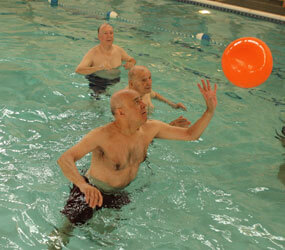After her husband of 55 years died a few years ago, Marie Cornely tried to live by herself in her South Carolina home. She soon realized it was just too much for her.
“I would have loved to have stayed in my own home,” said Cornely, who lived many years in Maryland when her husband was a physician at The Johns Hopkins Hospital in Baltimore.
“But it was impossible to care for the garden and the lawn and all that,” Cornely said. “I was depending on my son who lives in South Carolina to do that. It wasn’t fair to depend on one person like that.”
Cornely’s 13 children, four of whom live in the Baltimore area, researched and visited a variety of independent communities for their mother. Together, they and their mother decided that Mercy Ridge Retirement Community in Timonium would be a perfect new home.
Mercy Ridge offered numerous amenities, provided home services had an on-site chapel and opportunities for faith sharing.
Cornely sold her house to help pay the entrance fee and relocated five years ago. She calls it one of the best decisions she ever made.
“I have everything here that one could possibly need or want,” Cornely said. “We don’t have to cook or clean. Our dinner is always served, there’s Mass every morning and there are all kinds of groups for card playing, music, gardening and health. I’m happy here every day.”
Cornely’s path to an independent living community was a smart one, according to area experts. It’s critical to research all options when exploring facilities – paying close attention to location, price structures, services and reputation.
“This is a decision folks need to make on their own,” said Carol Volk, residency counselor at Fairhaven, a continuing care retirement community in Sykesville operated by EMA.
“So many people wait until there is a medical crisis and then they are at the mercy of who has space available,” she said. “Don’t wait until you are not able to make the decision for yourself.”
Volk recommended researching the track records of potential independent living communities. Find out if they are accredited and look into whether they have a history of financial stability, she said.
“When people enter a community, they are asked to provide a lot of information about their finances,” Volk said. “It’s only fair that they do the same and find out if (independent living communities) are in good shape themselves.”
Communities come in a wide variety of forms. Some require entrance fees and monthly rent, while others are solely rent-based. Some fully refund entrance fees, while others offer a percentage refund. Some are situated in pastoral settings, while others have an urban feel. Some allow pets, while others do not.
Patty Yingling, director of marketing at Mercy Ridge, said those considering a move should find out exactly what services are included in fees.
“We include everything in the monthly fee,” she said, “while some other communities are a la carte.”
It’s also critically important to investigate whether higher level medical services are available as a person ages and may need them, she said. Continuing care retirement communities usually offer different contract types that provide for differing levels of assisted living and nursing care.
“What comes with a continuing care community is a sense of security,” said George Clemens, administrator of business and fund development at Augsburg Lutheran Home and Village in Baltimore.
“If someone’s health fails or they fall and need rehabilitation, the advantage of living in a continuing care community is that you can move into that next level of care and still feel at home,” he said.
Part of any research should involve examining the culture of various communities, Clemens said.
“You want something that is going to fit you,” he said. “Talk to residents at whatever facility you visit. You should eat a meal there and visit multiple times. Pay attention to whether the staff is attentive to your needs.”
Clemens recommended asking a lot of questions – including queries about staff and resident turnover rates.
“If they have high turnover,” he said, “they probably aren’t going to take care of you well.”
Prices for independent living communities vary widely in the Maryland area depending on location, the size of housing and other factors. Entrance fees at Mercy Ridge range from $196,000 to $442,000. They cost $57,800 to $171,000 at Augsburg Lutheran and approximately $70,000 to $800,000 at Fairhaven.
Monthly fees at area independent living communities can range from $1,300 to more than $7,000, depending on the kind of residence.
Many communities, which usually have a minimum age of 62, have waiting lists – making it even more important to do research early. Yingling recommended beginning a search well before a person reaches his or her 70s.
“The one comment we hear all the time from our residents is that they wish they wouldn’t have waited so long,” Yingling said.
Volk said seniors are sometimes reluctant to leave their homes because they fear a loss of independence. The reality is that in a retirement community, she said, they gain independence because everyday chores like cooking and cleaning are taken care of.
“It gives them the opportunity to enjoy all of the many activities that are available,” said Volk, noting that Fairhaven rests on 300 acres and includes a nature trail and a bird sanctuary. Like other communities, Fairhaven offers regular lectures, musical performances, dance classes, card games, continuing educational classes and more.
“I really try to encourage them not to wait until it’s too late,” she said. “Come see what it’s all about.”
This is a corrected version of the print article, reflecting that Marie Cornely is the mother of 13 children.


